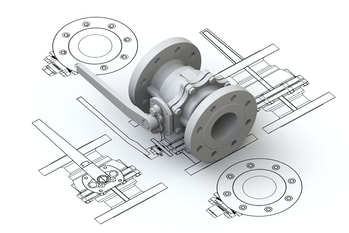
When it rains, the storm water that runs off your metal facility property is an industrial discharge.
Under the federal Clean Water Act, National Pollutant Discharge Elimination System (NPDES), and California Industrial General Permit (IGP), all metal facilities are required to have a storm water permit.
Pollution sources for storm water may include trucks coming/leaving your property, loading bays, parking lots, outdoor storage, material processing, and even your roof.
California’s storm water IGP encompasses all Standard Industrial Classifications (SIC industry codes) of the metals industry. This includes SIC codes 2000-3999 and 5093: metal casters, die casters, stampers, machine shops, recyclers, smelters, forgers, rolling mills, sheet metal facilities, and many others within the metals sector.
To find your Standard Industrial Classification by keyword search: CLICK HERE.
All California metalworking facilities--regardless of size, indoor vs. outdoor operations, number of employees, light industrial activities, or other previous exemptions--must comply with this law.
Compliance with the Industrial General Permit (IGP) includes several options:
In 2018, the Industrial General Permit (IGP) was amended to include TMDLs. This means you must know whether or not the storm water leaving your property goes to an impaired body of water. If it does, this could impact the numbers in your sampling requirements.
Under the federal Clean Water Act, National Pollutant Discharge Elimination System (NPDES), and California Industrial General Permit (IGP), all metal facilities are required to have a storm water permit.
Pollution sources for storm water may include trucks coming/leaving your property, loading bays, parking lots, outdoor storage, material processing, and even your roof.
California’s storm water IGP encompasses all Standard Industrial Classifications (SIC industry codes) of the metals industry. This includes SIC codes 2000-3999 and 5093: metal casters, die casters, stampers, machine shops, recyclers, smelters, forgers, rolling mills, sheet metal facilities, and many others within the metals sector.
To find your Standard Industrial Classification by keyword search: CLICK HERE.
All California metalworking facilities--regardless of size, indoor vs. outdoor operations, number of employees, light industrial activities, or other previous exemptions--must comply with this law.
Compliance with the Industrial General Permit (IGP) includes several options:
- File for a Permit: This includes a Storm Water Pollution Prevention Plan (SWPPP), testing storm water for pollutants, mandatory storm water BMPs, file test results and documents online through SMARTS, pay an annual fee, QISP training, potential Level 1 and Level 2 reports, potential assessment of pollution control treatment technologies, and much more. By filing for a permit, you will receive a Waste Discharge Identification Number: WDID#.
- File for a No Exposure Certification (NEC): The NEC is a filing from the facility owner certifying that there is no exposure of the facility's industrial activities, equipment and materials to storm water.
- File for a Notice of Non-Applicability (NONA): The NONA demonstrates that the facility is engineered and constructed to retain all storm water runoff even under historic rainfall conditions, or that the facility is not hydrolically connected to the waters of the United States.
In 2018, the Industrial General Permit (IGP) was amended to include TMDLs. This means you must know whether or not the storm water leaving your property goes to an impaired body of water. If it does, this could impact the numbers in your sampling requirements.
